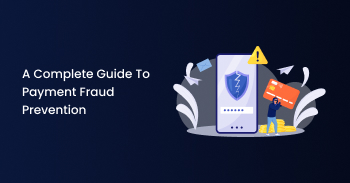What if your merchant had an associate business that was into money laundering or risky transactions? Roping merchants is an inevitable part of a business that involves payment processing and payment transactions. However, limiting the kinds of merchants based on their transaction histories can help Payment Service Providers (PSP), acquirer banks, Payment Aggregators (PA) and payment processors prevent fraudulent, risky, and non-compliant transactions. This can be achieved with a simple, secure and rapid merchant on-boarding risk scoring process that is digital and straightforward, assisting in identifying real-time fraud and risk transactions. Unlike traditional paper-based, the BANKiQ merchant on-boarding risk scoring process is vastly different and focused on benefiting acquirer banks, PAs, and PSPs in the era of instant and digital payments.
This blog will focus on the need for a merchant on-boarding solution and explain how BANKiQ’s on-boarding merchant risk scoring process is way ahead in identifying frauds and risk transactions
The need for risk scoring in merchant on-boarding
As stated, digital fraud has seen unprecedented levels of complexity in recent years, leading businesses to lose not just money but also reputations. To combat this, an initial level of scrutiny is necessary, where merchants get scored based on their business type, transaction model and compliant adherence. This way, businesses can stay ahead of risky and fraudulent transactions. Let’s analyze the significance of risk scoring in merchant acquisition service
1. Risk mitigation measures: Merchants flagged as having a risky profile are subjected to meticulous measures by
- Setting transaction limits, where merchants cannot receive or send beyond a certain threshold. This helps minimize financial risks and fraudulent transactions.
- Monitoring in true-real time with the aid of machine learning and advanced analytics. This helps track, monitor and report any suspicious transactions from usual payment processing behavior.
- Categorizing profiles based on risk scores helps enforce controls and also assists in decision making process.
2. Strict compliance: Risk scoring empowers acquirer banks, PAs and PSPs assess the originality of merchant profiles by
- Verifying business policies, registration status and other industry affiliations, thereby preventing profiles of financial risks from on-boarding.
- Analyzing business adherence to latest compliance regulations, practices and rules. This helps guide merchants in certain areas that need corrective action.
- Performing compliance audits and segmenting merchants per their risk levels will assist acquirer banks, PAs and PSPs in establishing periodic reviews and tightening on-going monitoring process.
3. Operational efficiency: The automated process of risk scoring enhances the merchant on-boarding process by
- Rapidly evaluating multiple merchant details within a short time frame.
- Reducing manual intervention in identifying profiles of high risk, thereby helping focus on more core challenges and solutions.
- Gaining real-time insights helps reject or accept merchant proposals, thereby reducing further processing time.
Now that we have analyzed the importance of risk scoring in the merchant on-boarding process, let’s discuss how BANKiQ’s FRC solution assists businesses in this process of roping in merchants and identifying fraudulent profiles with ease.
Before delving, let’s first understand BANKiQ’s merchant acquisition process/ approach.
Step1: Verify KYC
The merchant onboarding process begins with KYC documentation, which encompasses details about every aspect of their business. This includes all government IDs, their payment transaction details, regulatory practices and other significant documents. The KYC process has been digitized, facilitating a seamless and straightforward approach for both parties (merchants & payment service providers). As an initial step, this process not only helps analyze the document but also helps determine what kind of business the merchant is into, their risk value and other considerations associated with their onboarding. This is the stage where the merchant’s profile is scored if the risk is too much to handle.
Step 2: Merchant screening
The merchant screening process is one of the most important parts of the on-boarding segment. This is where BANKiQ’s on-board merchant screening solution comes into play. As an extensive feature of BANKiQ’s Fraud-Risk-Compliance, this assists in monitoring and tracking the merchant’s transaction behavior, their business partnerships, legal practices and other essential details in real-time, empowering payment gateways and acquirer banks to stay profitable and protected against financial loss and reputational damage.
Step 3: Issue merchant ID
When everything is sorted and all suspicious details are cleared, BANKiQ issues a unique merchant identification number for all merchants based on the risk level of each profile. For example, merchants whose profiles are non-compliance with the latest standards are categorized under a different group, whereas those involved in risky transactions are grouped under a different category. This way, payment service providers can easily identify merchants that need immediate corrective actions, transaction limits and other necessary steps that will help them react to emerging risks and opportunities.
Step 4: Transaction and reporting
As a final step, BANKiQ leverages its FRC solution, which is cognitive -ML enabled and supports true real-time transactions and suspicious transaction reporting. This helps PAs, PSPs, and acquirer banks stay well informed about each merchant transaction, including volume and type. With real-time monitoring, any deviations or unusual activities within the profile of the merchants are flagged, acting as proactive defensive mechanisms and stopping fraudulent activities before they can impact the payment ecosystem.
Thus, the BANKiQ merchant acquisition fraud prevention process comes to an end, acting as a pre-emptive precision for payment service providers to dynamically detect anomalies and stay ahead by implementing mitigation strategies and solutions.
How BANKiQ’s FRC solution for merchant on-boarding differs from the crowd
Known for its real-time, cognitive and pre-packaged rules and scenarios, the FRC solution of BANKiQ is one of its kind, supporting both real-time transaction monitoring and suspicious transaction reporting. It’s significance in the merchant on-boarding process is quite different and beneficial for payment providers struggling to flag suspicious merchant accounts and prevent fraudulent transactions. The following are the ways BANKiQ enhances merchant on-boarding process compared to its competitors
- Validating merchant lists against economic trade lists, politically exposed persons or industry-specific lists with questionable actions like money laundering and terrorism financing. Threat intelligence programs, along with merchant onboarding risk scoring, serve as a comprehensive approach to risk management and compliance in the payment industry.
- Connecting hidden relationships or uncovering disguise layering through attribute linking helps evaluate multiple data points. This helps in analyzing relationships among different entities that may be related to illegal transactions, fraud schemes or money laundering activities.
- Continuous monitoring of transaction details like volume of transactions, type of transactions, customer interactions and other details in real-time helps payment gateways track merchants nature of business. This assists in analyzing the merchant’s alignment towards compliance, adherence, and regulations. It also provides a visible view of the merchant’s business practices and their deviation from the committed promise, if any.
- Placing merchants under vigilance is a rare and unique approach of BANKiQ, where they closely monitor profiles of merchants flagged as extremely suspicious and risky. This list of merchants is subject to automated alerts in the event of any suspicious activity or non-compliant transactions.
Overall, BANKiQ’s FRC solution serves as one of the best merchant on-boarding solutions that can seamlessly be integrated into both on-premise and in the cloud. Built to empower payment aggregators, payment service providers and acquirer banks to track, monitor and report transactions, this true real-time transaction monitoring platform is what your business needs to stand against emerging potential threats and risky profiles.
Conclusion
In closing, it is evident that risk and fraud transactions are an unstoppable force in the world of payment processing. However, with careful monitoring and tracking of merchants, this can be limited to almost zero. Merchants serve as the carriers of risks and fraudulent transactions, so eliminating risky profiles in real-time helps closely monitor and scrutinize their activities, transactions, and suspicious behaviors. Businesses can leverage BANKiQ’s simple, digitized, and AI-ML powered FRC solution for pre-emptive precision in evaluating merchant profiles and proactively implement mitigation measures that help proactively manage potential threats, protect stakeholders, and uphold the integrity and stability of the financial system.|
By BankIQ





